 Moving electric charges produce magnetic fields. Magnetic fields exert forces on other moving charge.
The force a magnetic field exerts on a charge q moving with velocity v is called the magnetic
Lorentz force. It is given by
Moving electric charges produce magnetic fields. Magnetic fields exert forces on other moving charge.
The force a magnetic field exerts on a charge q moving with velocity v is called the magnetic
Lorentz force. It is given by
F = qv × B.
If a charge q is placed into an electric field produced by other charges, it
will be acted on by a force F = qE. This force is parallel
or anti-parallel to the field, depending on the sign of the charge.
 Moving electric charges produce magnetic fields. Magnetic fields exert forces on other moving charge.
The force a magnetic field exerts on a charge q moving with velocity v is called the magnetic
Lorentz force. It is given by
Moving electric charges produce magnetic fields. Magnetic fields exert forces on other moving charge.
The force a magnetic field exerts on a charge q moving with velocity v is called the magnetic
Lorentz force. It is given by
F = qv × B.
The force F is perpendicular to the direction of the magnetic
field B.
It also is perpendicular to the direction of the velocity v.
F is perpendicular to the plane that contains both v and B.
(Review the
vector or cross product!)
The magnitude of the Lorentz force F is F = qvB sinθ, where θ is
the smallest angle between the directions of the vectors v and
B.
If v and B are parallel or anti-parallel to each other,
then sinθ = 0 and F = 0. If v and
B are perpendicular to each other, then sinθ = 1 and F has its maximum
possible magnitude F = qvB.
If a charge q is moving with uniform velocity
v parallel to the direction of a uniform magnetic field B, it experiences no
force. It continues to move with uniform velocity v along a
straight line parallel to the field.
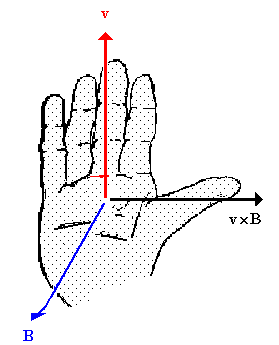 To find the direction of the
Lorentz force, use the right-hand rule. Let the fingers of your
right hand point in the direction of v. Orient the palm of
your hand, so that as you curl your fingers, you can sweep them over to
point into the direction of B. Your thumb points in the
direction of the vector product v × B. If q is
positive then this is the direction of F. If q is negative,
your thumb points opposite to the direction of F.
To find the direction of the
Lorentz force, use the right-hand rule. Let the fingers of your
right hand point in the direction of v. Orient the palm of
your hand, so that as you curl your fingers, you can sweep them over to
point into the direction of B. Your thumb points in the
direction of the vector product v × B. If q is
positive then this is the direction of F. If q is negative,
your thumb points opposite to the direction of F.
On the surface of a pulsar, or neutron star, the magnetic field may be as strong as 108 T. Consider the electron in a hydrogen atom on the surface of the neutron star. The average distance between the electron and the proton is 0.53*10-10 m. The average speed of the electron is 2.2*106 m/s. Compare the magnitude of the electric force that the electric field of the proton exerts on the electron with the maximum magnitude of the magnetic force that the magnetic field of the neutron star exerts on the electron. Is it reasonable to expect that the hydrogen atom will be strongly deformed by the magnetic field?
Solution:
 Consider a charged particle with mass m and charge q
which at t = 0 has a velocity v perpendicular to
B. This particle experiences a force with magnitude F = qvB perpendicular
to its velocity. A force perpendicular to the velocity results in
centripetal acceleration a = F/m = v2/r. The
particle will move along a circular path. The radius of the circle
is
Consider a charged particle with mass m and charge q
which at t = 0 has a velocity v perpendicular to
B. This particle experiences a force with magnitude F = qvB perpendicular
to its velocity. A force perpendicular to the velocity results in
centripetal acceleration a = F/m = v2/r. The
particle will move along a circular path. The radius of the circle
is
r = mv2/F = mv2/(qvB) =
mv/(qB),
and the circle lies in a plane perpendicular to
B. The
diagram on the right shows the paths followed by two charges, one
positive (red) and one negative (blue), in a magnetic field that points
into the page.
Since the magnetic force is perpendicular to the
velocity v = ∆r/∆t, it is, at any time, perpendicular to
the displacement ∆r. The work done by the magnetic force is
therefore zero, ∆W = F∙∆r = 0.
The magnetic force does no work.
The magnetic force changes the direction of the velocity, but it does not change the speed or the kinetic energy of the particle.
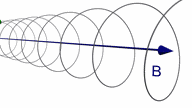 Assume a particle at t = 0 is moving
with a velocity v which has a component vperpendicular
perpendicular and a component vparallel parallel to
the magnetic field.
Assume a particle at t = 0 is moving
with a velocity v which has a component vperpendicular
perpendicular and a component vparallel parallel to
the magnetic field.
The path of the particle will be a spiral.
There is no acceleration parallel to B, but in the
plane perpendicular to B the centripetal acceleration
is a = qvperpendicularB/m, and the particle moves in a circle.
The superposition of these two motions results in a spiral path.
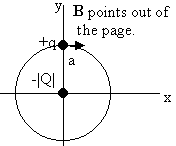 A
particle with mass M and charge q > 0 moves in a uniform magnetic field
B and also in the field of another charge Q < 0 located at the
origin. At t = 0 the particle is at x = z = 0, y = a, and its velocity
is v0i. For what B will the trajectory of the
particle be a circle of radius a centered at the origin?
A
particle with mass M and charge q > 0 moves in a uniform magnetic field
B and also in the field of another charge Q < 0 located at the
origin. At t = 0 the particle is at x = z = 0, y = a, and its velocity
is v0i. For what B will the trajectory of the
particle be a circle of radius a centered at the origin?
Solution:
An interactive 3D animation of the motion of a charged particle in a uniform magnetic field.

In a current carrying wire electrons move with an average velocity, called
the drift velocity vd. If the wire is placed into a
magnetic field B, a force will act on the wire.
Consider a straight section of wire of length L. The number of
moving electrons in this section is n-AL, where n-
is the electron density and A is the cross-sectional area of the wire. The
electrons move with the drift velocity vd. The force
F
on the section of wire is the sum of the forces on all the moving electrons,
F = -qn-ALvd × B
= jAL × B = IL × B.
Here we have used that -qn-vd = ρ-vd
= j, and that jA = I for a wire. Since I is not a vector and
we have to preserve the directional aspects of the vector product, we assign the
direction of the current density to L, which points in the
direction as j.
The force on a straight section of wire in a uniform field
B
is
F =
IL × B.
You can again use the right-hand rule to find the direction of the force.
Let the fingers of your right hand point in the direction of the current flow.
Orient the palm of your hand, so that as you curl your fingers, you can sweep
them over to point into the direction of B. Your thumb points in
the direction of the vector product F.
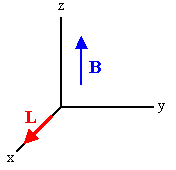 A wire carries a steady current of 2.4 A. A
straight section of the wire is 0.75 m long and lies along the x-axis
within a uniform field B = 1.6 T in the z-direction. If the
current is in the positive x-direction, what is the magnetic force on
the section of wire.
A wire carries a steady current of 2.4 A. A
straight section of the wire is 0.75 m long and lies along the x-axis
within a uniform field B = 1.6 T in the z-direction. If the
current is in the positive x-direction, what is the magnetic force on
the section of wire.
Solution:
 A wire having a mass per unit length of 0.5 g/cm carries a 2 A current
horizontally to the south. What are the direction and magnitude of the
minimum magnetic field needed to lift this wire vertically upward?
A wire having a mass per unit length of 0.5 g/cm carries a 2 A current
horizontally to the south. What are the direction and magnitude of the
minimum magnetic field needed to lift this wire vertically upward?
Solution:
External link: The Lorentz force on a wire (Youtube)
A demo: We pass a current through a wire a section of which passes
between the poles of two magnets, as shown below.
Make a prediction. When we connect the power supply, which way the wire will
move?
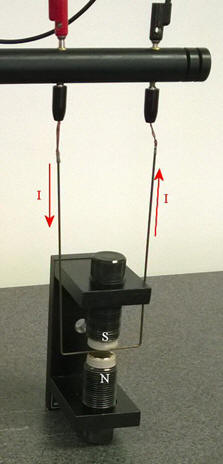
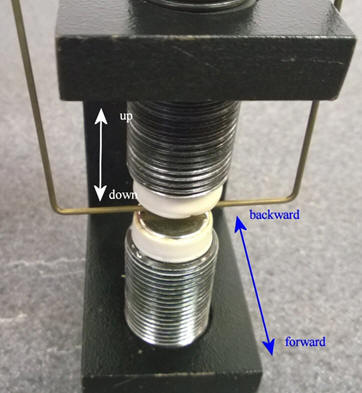
Discuss this with your fellow students in the discussion forum!
Review with them the Lorentz force and the right-hand rule.
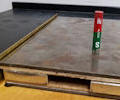 In this
video clip a hand crank generator is used to produce a voltage across
a thin rod which can move in a magnetic field produced by a set of magnets.
The north pole of the magnets points up.
In this
video clip a hand crank generator is used to produce a voltage across
a thin rod which can move in a magnetic field produced by a set of magnets.
The north pole of the magnets points up.
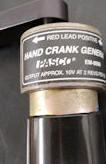 When
the crank is turned in the direction of the arrow shown, the red lead is
positive, and a current flows from the left to the right through the rod.
If the crank is turned the other way, a a current flows from the right to the
left through the rod.
When
the crank is turned in the direction of the arrow shown, the red lead is
positive, and a current flows from the left to the right through the rod.
If the crank is turned the other way, a a current flows from the right to the
left through the rod.
You can verify that the direction of the force F on the wire is the direction of IL × B.
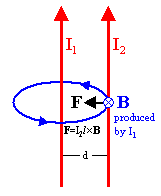 Parallel wires carrying currents will exert forces on each other. Each wire
produces a magnetic field, which influences the other wire. When the currents in
both wires flow in the same direction, then the force is attractive. When the
currents flow in opposite directions, then the force is repulsive.
Parallel wires carrying currents will exert forces on each other. Each wire
produces a magnetic field, which influences the other wire. When the currents in
both wires flow in the same direction, then the force is attractive. When the
currents flow in opposite directions, then the force is repulsive.
In the diagram on the right, both wires carry a current in the same direction. The
magnetic field produced by wire 1 at the location of wire 2 is B = μ0I1/(2πd)
pointing into the page. The force on a section of wire 2 of length
L
is is F = I2L × B.
F has magnitude F = I2LB = (μ0I1I2L)/(2πd)
and points towards wire 1. The force per unit length is (F/L) = (μ0I1I2)/(2πd)
towards wire 1. Similarly the force per unit length on wire 1 due to the field
produced by wire 2 is (F/L) = (μ0I1I2)/(2πd)
towards wire 2. (Newton's third law)
Remember:
Two parallel wires carrying current in the same direction attract each other.
Two parallel wires carrying current in opposite direction repel each other.
External link: Two wires (Youtube)